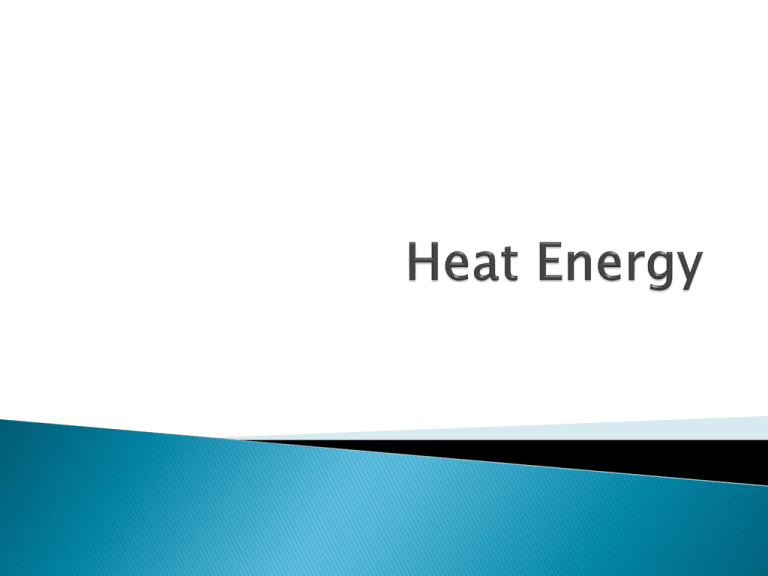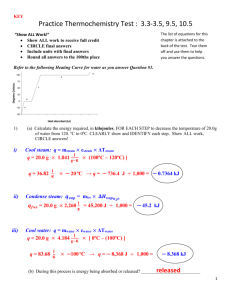Heat Energy - Chemistry
advertisement

Energy is transferred ◦ Exothermic – heat is released Heat exits ◦ Endothermic – heat is required or absorbed by reaction Measure energy in Joules or calories Temperature – average energy of molecular motion ◦ Size and type of particle do not matter Heat – total energy of molecular motion ◦ Speed, amount and type of particle matter The heat needed to raise the temperature of 1g of a substance by 1oC Water has a high heat capacity of 4.184 Joules or 1 calorie J cw 4.184 o g C Q m c T Q = heat (gained or lost) m = mass (in grams) c = specific heat value ∆T = change in temperature How much heat is lost when solid aluminum ingot with a mass of 4110g cools from 660oC to 25oC? The specific heat of aluminum is 0.903 J/(g x oC). Q m c T m = 4110g c = 0.903 J/(g x oC) ∆T = 660oC – 25oC = 635oC Q=? J o Q 4110 g 0.903 o 635 C g C Q = 2, 356, 695 J Or. . . 2, 357 kJ What happens to the change in temperature or equal masses of copper and water when equal amounts of heat energy are given? c for Cu = 0.387 J/(g x oC) Use mass = 1.0g Q=10.0J Cu J 10.0 J 1.0 g 0.387 o T g C H2O J 10.0 J 1.0 g 4.18 o T g C ∆T = 25.8oC ∆T = 2.4oC Calorimeter – a device used to measure the energy given off or absorbed during a chemical or physical change. A piece of unknown metal with mass 23.8 g is heated to 100.0oC and dropped into 50mL of water at 24.0oC. The final temperature of the system is 32.5oC. What is the specific heat of the metal? The density of water is 1g/mL. Metal m = 23.8g ∆T = 100 – 32.5 = 67.5oC density Water m = 50.0g ∆T = 32.5 – 24 = 8.5oC c = 4.18 J/(g x oC) mass 1g x volume 1mL 50mL X = 50.0g For water D = 1g/mL Heat gained by water = Heat lost by metal J o 50.0 g 4.18 o 8.5 C 23.8g c 67.5o C g C c = 1.1 J/(g x oC) The amount of energy needed to convert 1g of a substance from liquid to gas or from gas to liquid. Q m H v How much heat is required to vaporize 15g of liquid water? Hv of water = 2260 J/g J Q 15 g 2260 g Q = 33,900J or 33.9 kJ The amount of energy needed to melt 1g of solid substance to liquid. The amount of energy released when 1g of a liquid freezes or becomes solid. Q m H f How much energy is released when 25g of liquid water freezes? Hf of water = 334 J/g J Q 25 g 334 g Q = 8,350 J or 8.35 kJ A 30g sample of water is heated from 75oC to 135oC. How much energy is needed? Remember, you are crossing a phase change so you must account for that! Use both specific heat and heat of vaporization. Q m c T Q m H v J o Q 30 g 4.18 o 25 C g C Q = 3,135 J This accounts for liquid portion of water. J Q 30 g 2260 g Q = 67,800 J This accounts for the phase change (liquid to gas) J o Q 30 g 2.02 o 35 C g C Q = 2,121 J Accounts for gas (steam) portion of water. So, total energy is: 3,135J + 67,800J + 2,121J = 73,056J or 73 kJ






